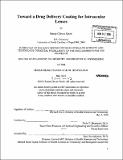Toward a drug delivery coating for intraocular lenses
Author(s)
Smith, Renée Chivon
DownloadFull printable version (14.76Mb)
Other Contributors
Harvard University--MIT Division of Health Sciences and Technology.
Advisor
Paula T. Hammond.
Terms of use
Metadata
Show full item recordAbstract
Layer-by-layer assembly has become a quintessential tool for the creation of versatile, dynamic nanostructured materials able to dictate cellular behavior through exquisite surface functionality and delivery of bioactive agents. The primary aim of this work was to use layer-by-layer assembly to advance ophthalmic drug delivery modalities post cataract surgery to overcome the challenges of traditional postoperative therapy. Hydrolytically degradable multilayer films were used to create a multi-drug delivery coating for intraocular lenses (IOL). The establishment of a drug delivery coating for intraocular lenses required key advances in ultrathin film technology. This thesis focused on rational polymer design for tailored release, incorporation of hydrophobic small molecule therapeutics, and controlled multi-agent release. Fabrication rules and design tools necessary to create hydrolytically degradable polyelectrolyte multilayer films with preprogrammed advanced engineered release kinetics were investigated. A correlation between polycation hydrophobicity, as determined using octanol:water coefficients, allowed for the reliable prediction of release dynamics. A novel ultrathin system able to produce programmable zero order release kinetics of uncharged or hydrophobic small molecule therapeutics was developed. Charged cyclodextrin polymers were essential for the trapping of cyclodextrin-drug complexes in stable, surface eroding films capable of sustained drug release without altering therapeutic activity. In vitro investigation of cellular interactions with hydrolytically degradable multilayer films containing anti-inflammatory agents was conducted. These anti-inflammatory films controlled inflammation over physiologically relevant timescales and maintained the transparency and optical clarity of the IOL. Lastly, the first multilayer thin film system able to address the demands of both infection and inflammation, using small molecule pharmaceutics is described. The power, versatility, and utility of this multi-functional system were highlighted by the creation of functional drug coatings on intraocular lenses, bandage, and sutures. These combination devices effectively prevented bacterial growth while suppressing the production of inflammatory cytokines. Combined, these efforts surmounted key challenges toward the development of intraocular lenses able to prevent complications of cataract surgery and enhanced the fundamental understanding of layer-by-layer systems.
Description
Thesis (Ph. D.)--Harvard-MIT Division of Health Sciences and Technology, 2010. Cataloged from PDF version of thesis. Includes bibliographical references.
Date issued
2010Department
Harvard University--MIT Division of Health Sciences and TechnologyPublisher
Massachusetts Institute of Technology
Keywords
Harvard University--MIT Division of Health Sciences and Technology.